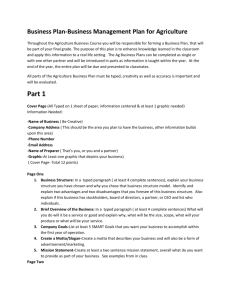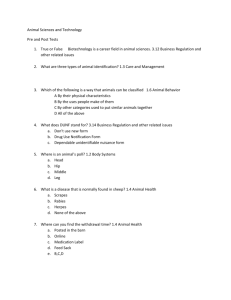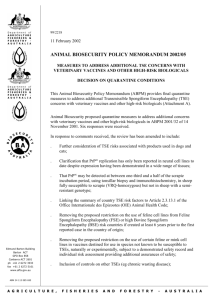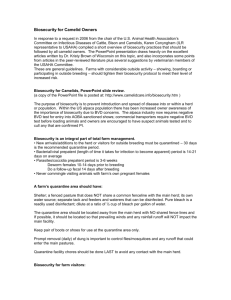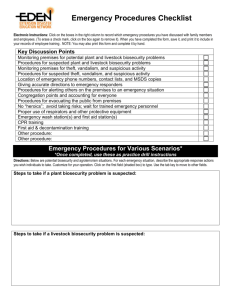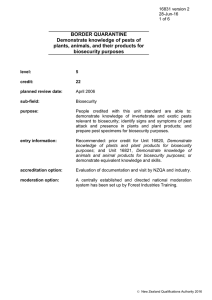National Plant Biosecurity RD&E Strategy
advertisement
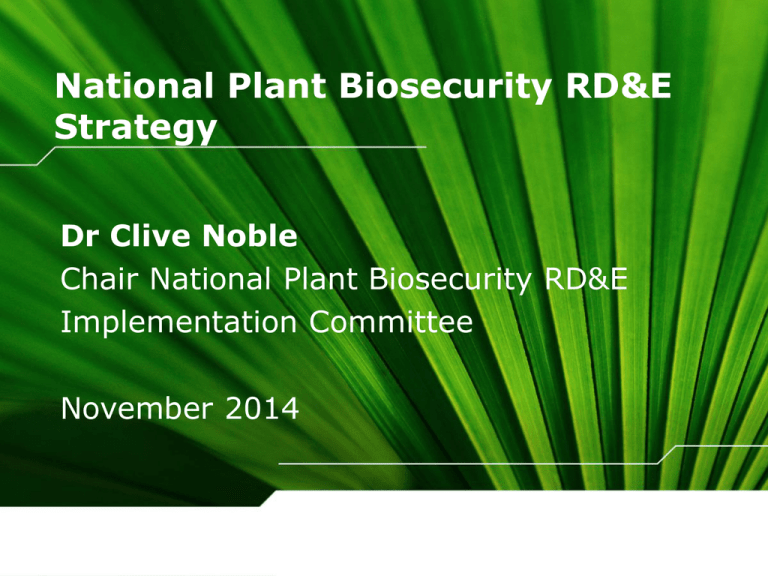
National Plant Biosecurity RD&E Strategy Dr Clive Noble Chair National Plant Biosecurity RD&E Implementation Committee November 2014 Why is the PB RDE Strategy needed? • Maintain the biosecurity status of Australia’s $28B plant industries, including pastures and hay • Initiated under NPIRDE Framework • Stakeholder identified issues (Nov 2012) Inadequate coordination between jurisdictions, R&D providers, policy/regulators, funders etc, Lack of coherent system for setting, reviewing and supporting priorities Lack of focussed process for the national assessment and distribution of R&D findings Lack of system to assess current capabilities, infrastructure, matching with current and future needs and addressing gaps Excessive reliance on short term funding On-going reductions in capacity and financial resources 2 AGSOC Committee • Agriculture Senior Officers National Research and Innovation Committee – replaces PISC RD&E Committee • All sector and cross sector strategies report to this committee One of two committees under Agricultural Senior Officers Committee The other being National Biosecurity Committee 3 Strategy Development • Covers 7 plant based RDCs and relevant to several animal based RDCs as scope covers weeds, pastures and food security • Links to PBCRC and CSIRO Biosecurity Flagship • In conjunction with NBC’s National RDE Framework Committee (IGAB RD&E Working Group) • Strong cross over between endemic and exotic pests implementation necessitate close collaboration with relevant sector specific strategies • Animal strategy developed in partnership • Wide engagement, including workshops, review sector strategies, industry R&D priorities & IGAB priorities 4 Strategy Development In Scope all pests of: • Primary Production crops including: Broad acre Native and Improved pasture Horticulture Forestry and timber production Floriculture Bees Food security for animals • Weeds • Pastures • Timber in service • Post-harvest horticulture and grains • Native plants acting as alternate hosts Out of Scope: • Environmental weeds • Native plant pests not impacting on production • Fresh water aquatic plant pests not impacting on production 5 Implementation Committee Name Organisation Dr Clive Noble (Chair) Independent Chair Mr Mike Ashton Qld DAFF Dr Gary Fitt CSIRO Mr Greg Fraser PHA Dr Satendra Kumar DPI NSW Mr Tim Lester CCRDC Mr John Lloyd HIAL Dr Rob Loughman DAFWA Dr Suzy Perry Qld DAFF Dr Kim Ritman Department of Agriculture Dr Michael Robinson Dr Simone Warner (Dr Martin Barlass) Pending PB CRC DEPI Vic GRDC Mr Rod Turner (Strategy Leader) PHA Dr Victoria Ludowici (Secretariat) PHA 6 Committee activities Three Implementation Committee meetings to date, planning the way forward; • Establish committee (Sponsors HIAL, DEPIV) • Project logic frame and key focus areas, leading to; Stakeholder engagement strategy Linkages to sectoral strategies of NPIRDE Framework National audit strategy Improvements to National PB RD&E system Forums for identifying RD&E priorities 7 NPBRDE Strategy logic frame Vision: world leading science-based systems and capability for safeguarding our plant sector from biosecurity threats Outcome: A nationally co-ordinated, responsive and focused plant biosecurity RD&E system that supports the plant based industries F o c u s a r e a s Fully functioning and efficient system –who does what, how & when Increased engagement and support for the RD&E system Nationally agreed RD&E focus areas (programs) & priorities Access to capability, infrastructure & finance as needed to deliver on priorities 8 Focus areas Fully functioning and efficient system –who does what, how & when: A national system for agreeing and co-ordinating RD&E activity Monitor RD&E activity Facilitating improvements in the plant biosecurity RD&E system Increased engagement and support for the RD&E system Increased stakeholder engagement and support for, and investment in, the plant biosecurity RD&E system, including government agencies and implementation of the IGAB 9 Focus areas Nationally agreed RD&E focus areas (programs) & priorities Develop range of potential national cross-sectoral program areas and prioritise Develop long term RD&E plans in each prioritised national program Engage with sectoral activities and agree priority activity Access to capability, infrastructure & finance as needed to deliver on priorities Assess current capability and infrastructure required to deliver on national programs Assess the coordination of capability, infrastructure and programs required to meet future national priorities Identify level of financial resourcing to meet future needs and assist organisations to access the appropriate investment 10 Stakeholder Engagement RDCs, Industry, PHC, governments (regulatory and R&D, NBC, PHC, IPAC), PBCRC, Universities, CSIRO, other National RDE Strategies, Museums & Botanic Gardens Will have specific strategy for each stakeholder group Multiple mechanisms; direct contacts, newsletters, website, workshops/ meetings, presentations Biosecurity Portal – Implementation Committee website: via PHA Various Forums 11 Stakeholders - Links to Other Strategies The Plant Biosecurity RDE Strategy initiating active links to all plant and relevant animal RD&E strategies National RDE Framework sector & cross sector strategies National Plant Biosecurity Strategy Intergovernmental Agreement on Biosecurity Schedule 8 Environmental Biosecurity Strategy – links with weeds and environmental pests National Fruit Fly Strategy Advisory Committee Other relevant plant RD&E committees Current actions, priorities, gaps 12 National Audit • Committee agreed not to undertake extensive audit as information quickly out of date and complex to undertake • Will undertake targeted focus area audits. First of these are: *Fruit fly *Diagnostics *Northern Australia Current and future needs Capability required to meet future needs Analyse current capability Determine gaps • Links to other audits including Subcommittee on Plant Health Diagnostic Standards (SPHDS) • Gap and capacity audit, not a snapshot in time 13 Improved plant health RD&E system • Deliverable of PBCRC • Implementation Committee to provide Steering Committee (commence Dec 9th) • 3 phases: Analysis of existing RD&E system to support the Australian plant health system (by June 2015) Development of options for improved RD&E system (by June 2016) Agreement on arrangements for implementation (by June 2018) 14 Forums • Forum proposed to combine with PBCRC Science Exchange 2015 will allow for all Australian researchers and regulators to meet to consider RD&E priorities • International RD&E forum being considered in 2016 • Scope of meetings will be to develop a blueprint to highlight high priority RD&E areas for consideration 15 • Implementation of the strategy is organised and well underway • We need and want active engagement How do you want to be engaged? Thank you 16
